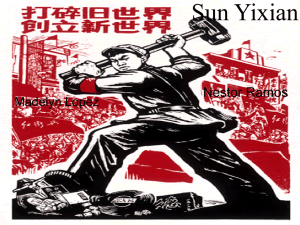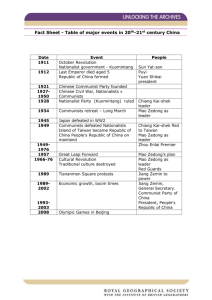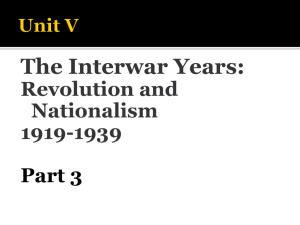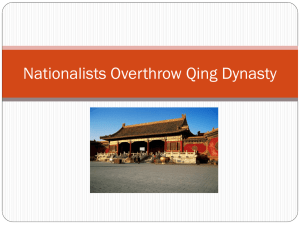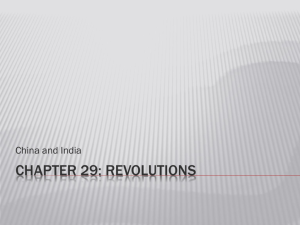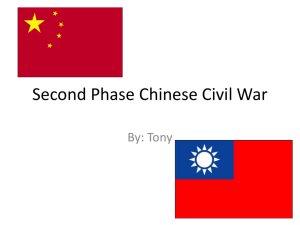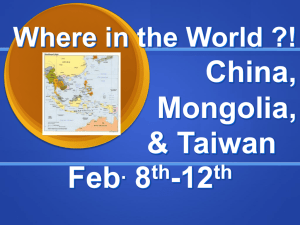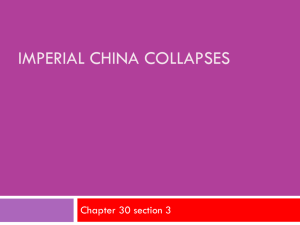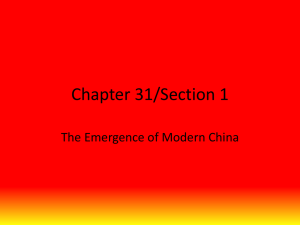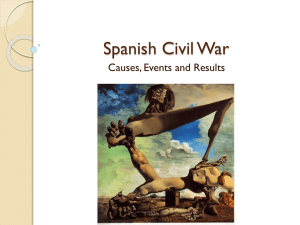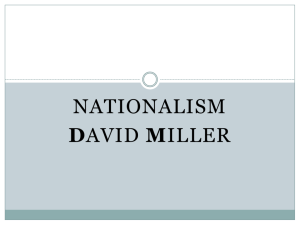MORE REVOLUTIONS
advertisement
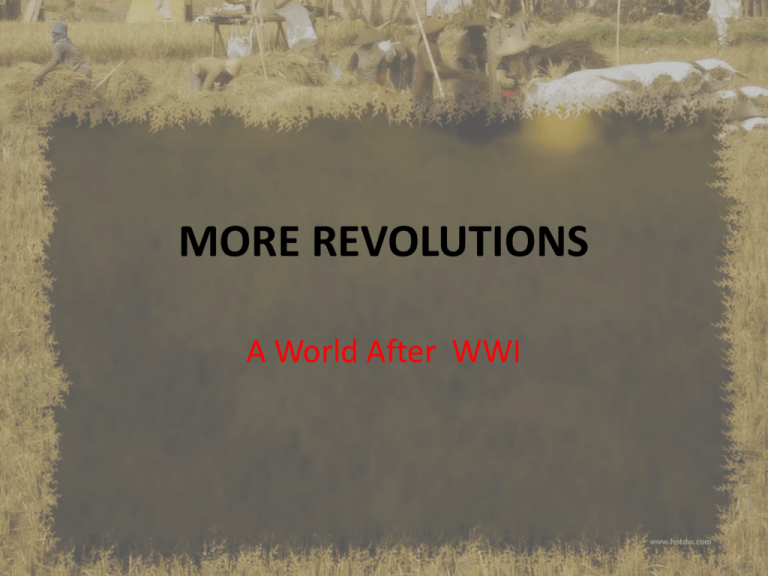
MORE REVOLUTIONS A World After WWI Revolution? • • • • Fear change? Embrace change? Consequences? Benefits? III. Imperial China Collapses A. China on the verge of a Revolution! 1. Foreign countries controlled trade & economic resources (imperialism) 2. wanted to build up (industrialization) 3. Need for modernization 4. Shaky Start for the New Republic a) The event that triggered civil war in China was the death of General Yuan Shikai 3 4 b) Kuomintang = Nationalist Party 1) Sun Yixian – first President = great leader a) Sun hoped to establish a modern government based on the “Three Principles of the People”: (1) nationalism—an end to foreign control (2) people’s rights—democracy (3) people’s livelihood—economic security for all Chinese b) main weaknesses of the new republic 1) Weak central rule 2) lack of respect from other nations 3) country needed modernizing 4) Lacked a military to FORCE it into place 5 Sun Yat-sen and Chiang Kai-shek 6 7 2. World War I Spells More Problems a) believed that Allies would return control of Chinese territories that Germany had imperialized before WWI b) Treaty of Versailles gave Japan those territories. c) Response: May Fourth Movement 1) Started with 3000 angry students uprising in Beijing and the movement spread a national movement - the people wanted to establish a strong & modern nation 8 C. The Communist Party in China 1. Mao Zedong- (1921) organizes a COMMUNIST movement a) would become China’s greatest revolutionary leader. b) Believed that the peasants could be the true revolutionaries 9 2. Lenin Befriends China a) 1923, Lenin sent military advisers & equipment to the Nationalists 1) Wanted to defeat the warlords 2) Lenin allies with them 3) in return allowed the Chinese Communists to join the Kuomintang. (Nationalist Party) 10 3. Peasants Align with the Communists a) Sun Yixian dies 1925 b) Nationalist named Jiang Jieshi (formerly called Chiang Kai-shek) headed the Kuomintang 1. Had business and banker supporters 2. promised democracy & political rights to all Chinese. 11 1) Nationalist government became less democratic & more corrupt 1) Less freedoms, rights, say in gov’t, equality c) many peasants began to support the Chinese Communist Party d) Mao divided land that the Communists won among the local farmers 12 4. Nationalists & Communists Clash! a) Nationalists turn against the Communists b) 1928, Jiang became president of the Nationalist Republic of China 1) Jiang ordered the Shanghai Massacre a) Nearly wiped out the Chinese Communist Party. 13 b) Nationalist Republic of China 1) Great Britain & the United States formally recognized the new government 2) the Soviet Union did not! 14 D. Bloody Civil War Rages in China 1. 1930, Nationalists vs. Communists 2. The Long March Mao’s (red army) Communists vs. Jiang’s Nationalists 1. Communists outnumbered and they fled 2. 6000 mile journey, over a year long 3. 10,000-30,000 reached safely in NW China 4. Jiang’s forces couldn’t reach them, so the Red Army survived in caves 5. at least 2/3 of the original marchers did not complete the journey but more people joined the Communists along the way 15 16 17 18 2. Civil War suspended a) 1937, the Japanese launched an all-out invasion of Manchuria, China. b) Invasion and bombing spread c) By 1938, Japan held control of a large part of China d) Nationalists & Communists temporarily united to fight the Japanese Eventually, sparks up… WWII 19 IV. Nationalism in India & Southwest Asia! A. Setting the Stage….. 1. end of World War I a) broke up the Ottoman &Austrian Empire b) Treaty of Versailles said “imperialized land” would receive more “Selfdetermination” [control in their own government] c) India - nationalism & democratic ideas growing 20 21 B. Indian Nationalism grows 1.Remember: Gandhi, Sepoys, Rebellion against the British rule??? World War I increases Nationalist Activity a) By the end of WWI, British had established a Parliament in India a) Gave Indians more of a say in their gov’t b) But the British put in policies like the Rowlett Acts a) allowed the government to jail protesters without trial for as long as two years 1) Causing violent protests! 22 2) British government promised reforms that would eventually lead to selfgovernment if Indians served in WWI 3) Indian National Congress Party and the Muslim League fought to end foreign rule in India completely! 2) They wanted complete independence! 23 2. Amritsar Massacre a) demonstration alarmed the British 1) especially the alliance of Hindus & Muslims (worked together for independence) 2) British Government had OUTLAWED public meetings b) British believed People were openly defying the ban c) troops fired on the crowd without warning killed 400 Indians, 1,200 wounded. 24 25 C. Gandhi’s Tactics of Nonviolence 1. Mohandas K. Gandhi a) leader of the independence movement b) Teachings blended ideas from all of the major world religions 1) Hinduism 2) Islam 3) Christianity 26 27 2. Non-cooperation!! a) 1920, the Congress Party decided to practice/live by: 1) civil disobedience (a) the deliberate & public refusal to obey an unjust law (b) nonviolence as the means to achieve independence 2) weaken the British government’s authority & economic power over India. 28 3. Boycotts a) refuse to 1) buy British goods 2) Attend government schools 3) pay British taxes 4) vote in elections 5) a) despite Gandhi’s pleas for nonviolence, protests often led to riots. 29 5. The Salt March a) 1930, Gandhi organized a demonstration to defy the hated Salt Acts. 1) British laws 2) could buy salt from no other source but the government. 3) had to pay sales tax on salt 30 31 b) walked about 240 miles to the seacoast c) began to make their own salt by collecting seawater & letting it evaporate d) Police officers with steel-tipped clubs attacked the demonstrators e) won worldwide support for Gandhi’s independence movement 32 D. Britain Grants Limited Self-Rule 1. 1935, the British Parliament passed the Government of India Act. a) provided local self-government b) limited democratic elections c) not total independence 2. Indian Muslims feared that Hindus would control India if it won independence 33 34 E. Nationalism in Southwest Asia 1. Ottoman Empire was forced to give up all its territories except Turkey 2. Turkey becomes a Republic 2. People have a say, elections, voting. 35 36 a) Mustafa Kemal -Ataturk—“father of the Turks.” 1) 2) successfully led Turkish nationalists in fighting back the Greeks (who tried to invade and conquer them) & their British backers Helped to overthrow the Ottoman sultan 37 Reform in Turkey 2) 1923, Kemal became the president of the new Republic of Turkey, the first republic in Southwest Asia a) separated the laws of Islam from the laws of the nation b) abolished religious courts & created a new legal system based on European law c) granted women the right to vote & to hold public Office d) launched government-funded programs to industrialize Turkey & to spur economic growth 38 2. Persia Becomes Iran a) b) c) d) the British tried to take over all of Persia. triggered a nationalist revolt in Persia 1921 Persian army officer seized power. 1925 he deposed the ruling shah. 39 e) Persia’s new leader is Reza Shah Pahlavi 40 41 1) 2) 3) 4) 5) 6) established public schools built roads & railroads promoted industrial growth extended women’s rights kept all power in his own hands 1935, changed the name to the traditional name Iran 42 43 3. Saudi Arabia Keeps Islamic Traditions a) powerful Arabian family began a successful campaign to unify Arabia 1) 1932, renamed Saudi Arabia 2) Government based on custom, religion, & family ties 3) no efforts to begin to practice democracy 44 4. Oil Drives Development a) land around the Persian Gulf has nearly two-thirds of the world’s known supply of oil (Iran, Iraq, Saudi Arabia, Kuwait) b) oil brought huge profits c) Western nations tried to dominate this region 45
